Family : Procyonidae

Text © Dr Davide Guadagnini

English translation by Mario Beltramini
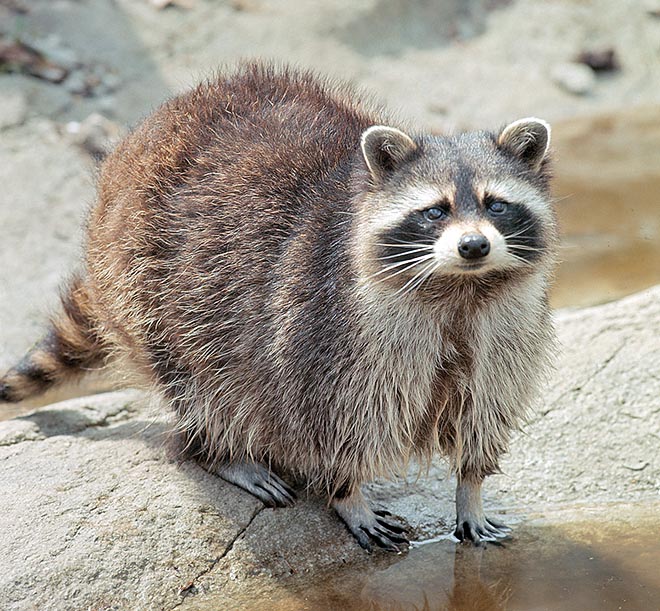
Native to America, the Procyon lotor is now naturalized in France, Germany, Italy, Caucasus and present in Japan © Giuseppe Mazza
The Raccoon or Coon (Procyon lotor Linnaeus 1758) is a carnivore of average dimensions, having the appearance of a small “masked little bear”. It belongs to the order of the Carnivores (Carnivora), to the family of Procyonidae, genus Procyon and specie Procyon lotor.
To the genus Procyon belong three species: Procyon lotor, Procyon cancrivorus e Procyon pygmaeus.
In the past, to such genus, were assigned other species, endemic to some islands of Central America, now considered as subspecies of the Procyon lotor.
They are the Procyon lotor maynardi (Raccoon of the Bahamas), the Procyon lotor minor (Raccoon of Guadeloupe), the Procyon lotor insularis (Raccoon of Tres Marias), and the extinct Procyon lotor gloveralleni (Raccoon of Barbados).
These subspecies are in addition to other 19 subspecies that vary mainly for the size and the colouration.
The name of the genus Procyon comes from the Greek πρὸ (pro) = before and κύων (kyon) = dog and means “before the dog, similar to the dog” referring to the look of the animal.
The specific name comes from the Latin “lotor”, wash-house, with reference to the fact that it has the habit to rinse its food if possible even if that food is some small aquatic animal as it is often the case.
Zoogeography
The natural distribution of the raccoon goes from southern Canada to most of the USA, to Mexico, part of Central America up to Panama. The raccoon has been introduced in the old world twice since the middle of the twentieth century. It is nowadays present in Japan, naturalized in some zones of France, Germany, Italy, in the regions of Caucasus.
In the native area, the smaller subspecies are distributed along the southern coasts of Florida and in the adjacent islands. The bigger subspecies, more diffused in most of the American territory are the nominal subspecies Procyon lotor lotor and the Procyon lotor hirsut.
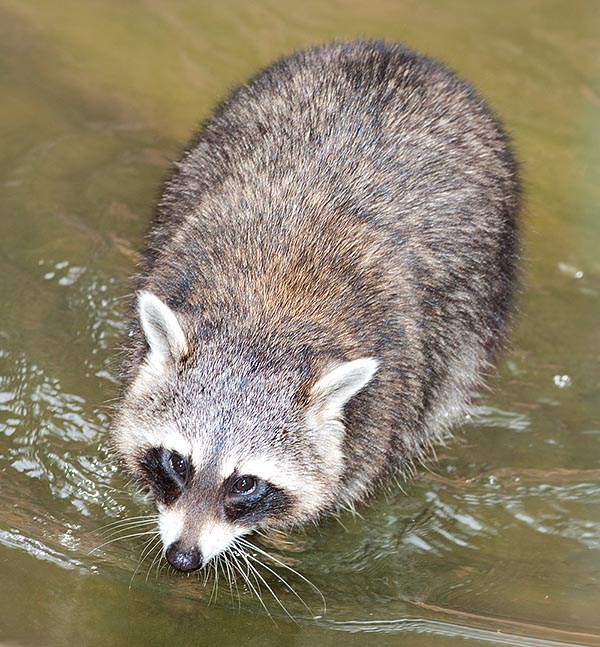
It adapts to various habitats, preferably woody and swampy © Giuseppe Mazza
Ecology-Habitat
The natural habitat of the raccoon is very varied thanks to the great adaptability of the species.
It lives in the temperate deciduous forests, swampy and coastal environments, mountain areas and even highly anthropized and urban areas. The raccoons, regardless the habitat where they live, must have available horizontal (natural or artificial) structures on which to climb and hide when feeling menaced or insecure. Basically they tend to avoid excessively open spaces having no tree cover.
Morpho-physiology
The raccoon is a rather stocky small animal and mainly similar to a small bear with tail. It compact aspect is deceiving being able to reach twice that length if interested like reaching a roof or enter a garbage container as high as 145 cm.
It is about 40-70 cm long, it has a height at the withers of 22-31 cm and has a weight, depending on the subspecies and the habitat and season, that may vary between the 2 kg and almost 14 kg (an average around the 4-9 kg).
The weight can considerably vary between the period when the accumulation of winter fat is maximal and that when it is minimal.
The head is enlarged, the muzzle is thinned, the ears are big, partially rounded and edged white. The limbs are averagely long and covered by short hair; the fore ones have 5 fingers clearly separated and extremely mobile that allow good manipulative skills to the animal.
The coat, endowed with a thick underfur, is greyish with shades and nuances going from the yellowish to the reddish-brown, more or less dark, depending on the subjects. The ventral parts are clear. The head, having a shorter hair, is characterized by a dark facial mask crossing it from a cheek to the other, passing by the eyes.
The little mask given by the union of two large spots rather dark and curved beneath the cheeks that are very evident because they contrast with the surrounding whitish parts that form above a sort of ample eyebrow and below interest vast lateral zones of the muzzle. Rightly the look of the face (that recalls a bandit’s mask) combined with the intelligence and the curiosity of the animal, that thanks to the manipulative capacities recall abilities typical of the dogs as well as of the primates, have been decisive in creating the reputation of “mischevious, rascal and scoundrel” animal, typical of this species.
The thick tail has 5-7 dark transversal rings on a greyish background and is averagely long around 25 cm. The eyes, that thanks to the mask and the good mimic capacities of the face prove to be expressive, in this species are of a very dark brown colour, almost black. Melanic and albino forms do exist.
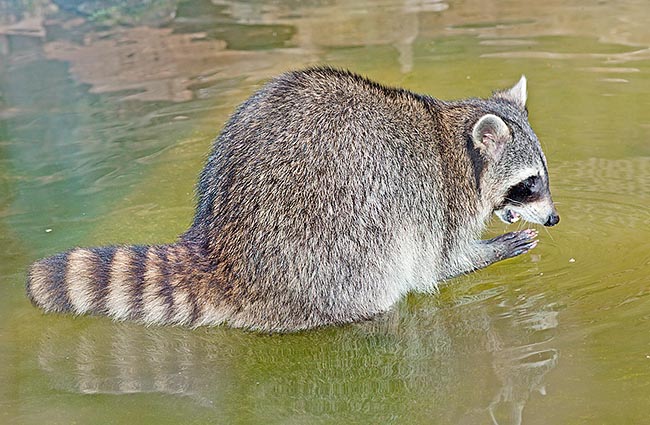
With its paws it sieves the mud and looks under the rocks for small preys that then accurately washes © G. Mazza
Ethology-Reproductive Biology
The raccoon has omnivorous and opportunistic alimentary habits.
Usually, the 2/3 of the diet are formed by food of animal origin and the remaining 1/3 by food of vegetal origin. The preys are mainly formed by invertebrates but it eats also small vertebrates such as fishes, amphibians, reptilians, small birds (and their eggs) and small rodents.
The food of vegetal origin consists mainly of fruits, berries, seeds, acorns and nuts.
The raccoon has a great tactile sensitivity, in fact, for seizing the small aquatic animals it eats, it looks for them fingering in the water with the fore paws. Keeping the fingers well apart being them devoid of interdigital membranes) it looks for the food under the stones, the rocks and searches into the cavities. Once identified tactilely the prey, it sniffs it accurately, then deposits it or begins to eat it slowly. The small crustaceans are swallowed whole, whilst the big ones are bitten at the level of the chelae and then devoured starting from the rear part of the body. Mollusks are opened and thoroughly emptied. The raccoon is an animal extremely adaptable and in some sites, accustomed to human presence, goes easily into the urban areas looking for food that it recovers rummaging in the garbage. The eyesight, for the raccoon, is fairly good on the short distances; hearing and smell are quite developed.
In most mammals the ovulation takes place during the period of the oestrus independently from the mating. In some mammal, among which the raccoons, the ovulation is not spontaneous but is induced by the copulation. This ovulation appears to be advantageous for those species where the females have a long and variable receptive period. For the raccoon the induced ovulation can be related to the existence, in the male, of a particularly developped baculum and horny spicules, oriented backwards, in the basal part of the glans. These anatomic structures ensure, in the female, the stimuli necessary to the ovulation. The couplings occur, as a rule, in midwinter (between January and March when the hours of light start to get longer) with anticipation going south. The male and the female separate after the mating, and the male can mate later on with various other females. The gestation lasts about two months (54-65 days) and the brood is formed usually by 2-5 puppies.
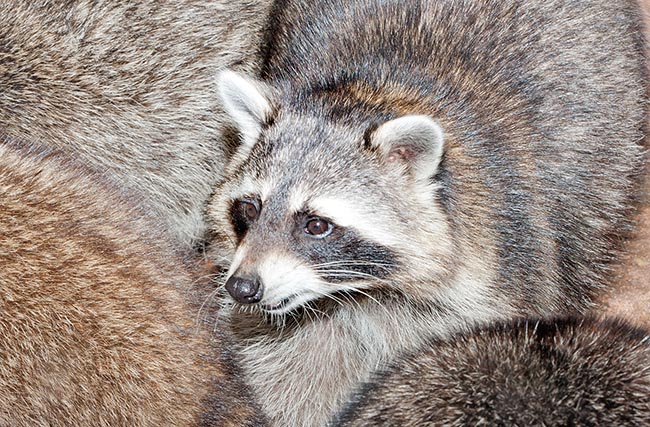
Especially in winter it holes up in small groups for long sleeps, but does not hibernate © Giuseppe Mazza
Usually, the females isolate themselves for the delivery and till when the puppies have grown enough to defend from the other adults that in some cases might be dangerous. At birth the weight of the puppies is of about 65-80 g and are about 9-11 cm long. The down covering them is clear, the mask is already evident. After about 2-3 weeks the ears and eyes do open.
During the first lactations the female keeps stretched on the ground then later on assumes a standing position. The milk of the raccoons has a low contents of fats and proteins. The young perform the first excursions between the sixth and the ninth week of age. During this period some females change the den to the young; in particular they carry them from higher places (trees) to the ground. Usually the cavities in the trees are the preferred places for the breeding of the young. However, during the exploratory phase, when they start going around, they could fall from above or not regain the den. Moving them to the ground these risks are greatly reduced. The young, when about 2 months old, start feeding of solid food. When they accompany the mother, this keeps the family the most possible united launching acute cries (some verses resemble chirpings of birds) at regular intervals.
When about 4 months the puppies are totally weaned and by autumn are now independent and able to settle in their own territory. This leads them to move even of some tens of km from the birth area (up to some hundreds of km). Some females can already deliver during the year of their birth, the males usually become mature by around the first year of age. In a typical habitat of the northern USA the density that a population of raccoons may reach is of about 7 individuals per square km.
The annual cycle of the raccoons has a winter phase in which they are quite inactive, corresponding to the period when they spend a lot of time holed up (for the northernmost populations of the range). They are less active when the temperature reaches values around the -4 °C. In case of particularly hard weather conditions, they can stay holed up for entire weeks without eating, in a state of sound sleep that however, not leading to any slowing of the basal metabolic rate or lowering of the body temperature, cannot be considered as a lethargy (at the smallest alarm or noise, the raccoons are active and reactive with a delay proportional to the sleeping time).
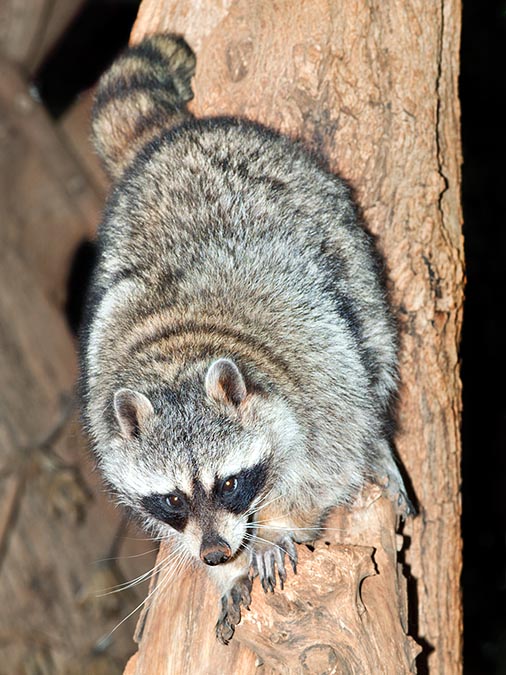
Excellent climber, can descend from the trees head down © Giuseppe Mazza
In the winter shelters it is possible to observe more specimens staying together. During the good season, the raccoons are active mainly by night and spend the day inside dens or shelters. The abundance and the distribution of suitable shelters appears to be crucial for the distribution itself of the population. In particularly are by far preferred the hollows on the trees and the good protection seems to be more important than the presence of water and food.
The raccoon is an excellent climber and can get down from the trees head down. The extension of the territories is subject to considerable variations in relation to the shelter areas and the food resources offered by the territory. The raccoon is quite a creature of habit; after out of the den it goes in the preferred sites looking for food; after some areas it becomes more active and begins to explore new places always looking for food. If during the explorative phase it finds a place abounding of food, this will be to be visited during the following nights. Therefore, the centre of the displacements varies in relation to the distribution and variation of the food resources. The night transfers conclude with the return to the den which is not necessarily the same from which the animal had previously left.
The raccoons do not make great leaps and can run at 15-24 km per hour at the most; they are excellent swimmers.
Though being not particularly territorial animals they tend to keep isolated, especially during the periods of nourishing; in spite of the ample overlapping of the individual family areas, the raccoons are able to reduce at the least the hostile interactions. In this species there is not a true and real territorial behaviour that pushes it to defend actively the frequented territory. On the contrary, it often shows social behaviours with related females living together or groups of males, who know each other, living in group for contrasting possible alien individuals.
In aggressive posture, the raccoon keeps the head low and the ears folded, exhibits the teeth and ruffles the hair on the neck and the shoulders and emits low grumblings.
For communicating with each other, the raccoons emit a wide range of vocalizations. The raccoon, especially in North America, is very sensitive to the distemper virus that causes many fatalities. It is also a good reservoir for the rabies virus in North America. Habitually, the raccoons are predated by predatory birds and by other carnivorous mammals, but this does not constitute a problem for the species that is considered as invasive and dangerous for the habitats where it was not an original element. When captive, the raccoon may live 20 and more years. The name of “washer” has been assigned to the raccoons because of their habit of immersing the food in the water, instinctive habit that simulates the search for food in an aquatic environment. This habit can be forgotten when water is not present at a specific food station. The raccoon is a very nice animal, in addition to the characteristics seen before, also for the range of nice and somewhat anthropomorphic postures it often assumes (standing upright on its hind legs, sitting on the pelvis with raised chest, breastfeeding the puppies in seated position, sprawled either prone or supine, etc..).
Synonyms
Ursus lotor (Linnaeus, 1758), Procyon insularis (Merriam, 1898), Procyon maynardi (Bangs, 1898), Procyon minor (Miller, 1911), Procyon gloveralleni (Nelson & Goldman, 1930).
